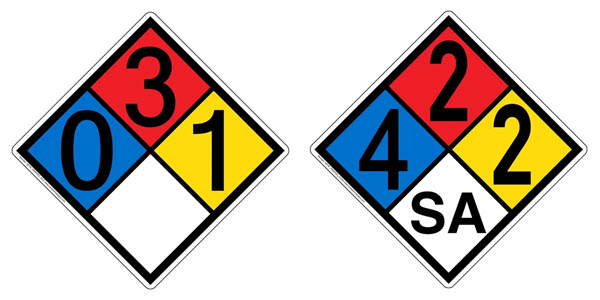
Understanding the NFPA Diamond

The NFPA “fire diamond” or “hazmat diamond” quickly and easily identifies the risks posed by short-term, acute exposure to a material under conditions of fire, spill or similar emergencies. This information is invaluable to emergency personnel to help them determine what, if any, specialty equipment or procedures should be followed in an emergency response. In the workplace, the diamond can help remind employees to use necessary protective equipment and procedures, as well.
The NFPA Diamond Hazards
The diamond system is described in NFPA Standard 704, maintained by the National Fire Protection Association. The system identifies four key hazards (health, flammability, instability and special) and their degree of severity. Hazard severity is rated numerically, ranging from 0 (minimal) to 4 (severe).
The hazards are identified by position and color:
– Health: Blue, left corner
– Flammability: Red, top corner
– Instability: Yellow, right corner
– Special: White, bottom corner

Various symbols are used in the special hazards section to indicate the material has unusual reactivity with water, is oxidizing, corrosive or has other unusual properties. Check with local authorities for required and/or non-permitted symbols for this area.
Where to post NFPA placards
Refer to NFPA 704 Section 4.3, Location of Signs, for specifics. At a minimum, diamonds should be posted on the two exterior walls of a facility, at access to a room or area or at each main access to an exterior storage area. Remember, placards give key hazard information to emergency responders, so they should be visible wherever responders are likely to enter. If there are several areas where responders could enter, there should be several placards. If you’re not sure, ask for advice from your local emergency departments.
NFPA 704 Resources:
View NFPA diamond explanation guides here.
Read our Resource Bulletin on NFPA 704 Signs (pdf).

